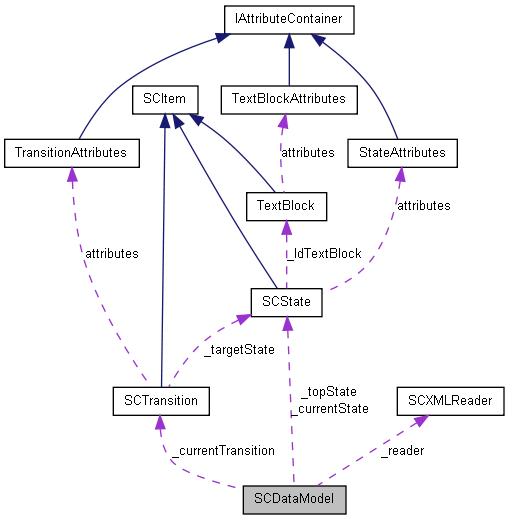#include <scdatamodel.h>
Collaboration diagram for SCDataModel:

Signals | |
| void | openCompleted (bool sucess, QStringList message) |
| void | newStateSignal (SCState *newState) |
| void | newTransitionSignal (SCTransition *newTransition) |
Public Member Functions | |
| void | open (QString scxmlFile) |
| bool | save (QString scxmlFile, QString &message) |
| void | initializeEmptyStateMachine () |
| void | getStates (QList< SCState * > &list) |
| void | getAllStates (QList< SCState * > &list) |
| SCState * | getStateByName (QString name) |
| SCTransition * | getTransitionByName (QString name) |
| QObject * | getItemByName (QString name) |
| SCState * | getTopState () |
| void | setScene (QGraphicsScene *scene) |
| QGraphicsScene * | getScene () |
| SCState * | insertNewState (SCState *parent) |
| SCTransition * | insertNewTransition (SCState *source, QString event) |
| void | logError (QString message) |
| inform the user there was an error | |
| void | logInfo (QString message) |
| inform the user of anything that is not an error such as progress, etc | |
Static Public Member Functions | |
| static SCDataModel * | singleton () |
| static SCState * | getAsState (QObject *) |
| static SCTransition * | getAsTransition (QObject *) |
| static TextBlock * | getAsTextBlock (QObject *) |
Member Function Documentation
| void SCDataModel::getAllStates | ( | QList< SCState * > & | list | ) |
Here is the call graph for this function:

| SCState * SCDataModel::getAsState | ( | QObject * | o | ) | [static] |
| TextBlock * SCDataModel::getAsTextBlock | ( | QObject * | o | ) | [static] |
| SCTransition * SCDataModel::getAsTransition | ( | QObject * | o | ) | [static] |
| QObject * SCDataModel::getItemByName | ( | QString | name | ) |
Here is the call graph for this function:

| QGraphicsScene * SCDataModel::getScene | ( | ) |
Here is the caller graph for this function:

| SCState * SCDataModel::getStateByName | ( | QString | name | ) |
Here is the call graph for this function:

Here is the caller graph for this function:

| void SCDataModel::getStates | ( | QList< SCState * > & | list | ) |
Here is the call graph for this function:

| SCState * SCDataModel::getTopState | ( | ) |
Here is the caller graph for this function:

| SCTransition * SCDataModel::getTransitionByName | ( | QString | name | ) |
Here is the call graph for this function:

Here is the caller graph for this function:

| void SCDataModel::initializeEmptyStateMachine | ( | ) |
Here is the call graph for this function:

Here is the caller graph for this function:

Here is the call graph for this function:

| SCTransition * SCDataModel::insertNewTransition | ( | SCState * | source, | |
| QString | event | |||
| ) |
Here is the call graph for this function:

| void SCDataModel::logError | ( | QString | message | ) |
inform the user there was an error
Here is the caller graph for this function:

| void SCDataModel::logInfo | ( | QString | message | ) |
inform the user of anything that is not an error such as progress, etc
| void SCDataModel::newStateSignal | ( | SCState * | newState | ) | [signal] |
Here is the caller graph for this function:

| void SCDataModel::newTransitionSignal | ( | SCTransition * | newTransition | ) | [signal] |
Here is the caller graph for this function:

| void SCDataModel::open | ( | QString | scxmlFile | ) |
Here is the call graph for this function:

Here is the caller graph for this function:

| void SCDataModel::openCompleted | ( | bool | sucess, | |
| QStringList | message | |||
| ) | [signal] |
| bool SCDataModel::save | ( | QString | scxmlFile, | |
| QString & | message | |||
| ) |
Here is the call graph for this function:

Here is the caller graph for this function:

| void SCDataModel::setScene | ( | QGraphicsScene * | scene | ) |
Here is the caller graph for this function:

| SCDataModel * SCDataModel::singleton | ( | ) | [static] |
Here is the caller graph for this function:

The documentation for this class was generated from the following files:
- C:/Users/David/Documents/QtProjects/visualsc/scdatamodel/scdatamodel.h
- C:/Users/David/Documents/QtProjects/visualsc/bin/debug/moc_scdatamodel.cpp
- C:/Users/David/Documents/QtProjects/visualsc/scdatamodel/scdatamodel.cpp
 1.7.1
1.7.1